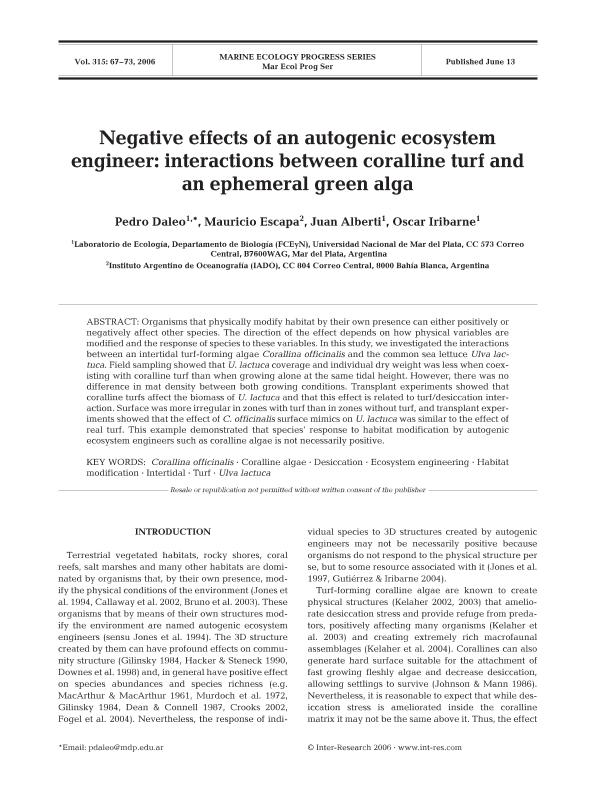Artículo
Negative effects of an autogenic ecosystem engineer: interactions between coralline turf and an ephemeral green alga
Fecha de publicación:
06/2006
Editorial:
Inter-Research
Revista:
Marine Ecology Progress Series
ISSN:
0171-8630
Idioma:
Inglés
Tipo de recurso:
Artículo publicado
Clasificación temática:
Resumen
Organisms that physically modify habitat by their own presence can either positively or negatively affect other species. The direction of the effect depends on how physical variables are modified and the response of species to these variables. In this study, we investigated the interactions between an intertidal turf-forming algae Corallina officinalis and the common sea lettuce Ulva lactuca. Field sampling showed that U. lactuca coverage and individual dry weight was less when coexisting with coralline turf than when growing alone at the same tidal height. However, there was no difference in mat density between both growing conditions. Transplant experiments showed that coralline turfs affect the biomass of U. lactuca and that this effect is related to turf/desiccation interaction. Surface was more irregular in zones with turf than in zones without turf, and transplant experiments showed that the effect of C. officinalis surface mimics on U. lactuca was similar to the effect of real turf. This example demonstrated that species’ response to habitat modification by autogenic ecosystem engineers such as coralline algae is not necessarily positive.
Archivos asociados
Licencia
Identificadores
Colecciones
Articulos(CCT - MAR DEL PLATA)
Articulos de CTRO.CIENTIFICO TECNOL.CONICET - MAR DEL PLATA
Articulos de CTRO.CIENTIFICO TECNOL.CONICET - MAR DEL PLATA
Articulos(IADO)
Articulos de INST.ARG.DE OCEANOGRAFIA (I)
Articulos de INST.ARG.DE OCEANOGRAFIA (I)
Citación
Daleo, Pedro; Escapa, Carlos Mauricio; Alberti, Juan; Iribarne, Oscar Osvaldo; Negative effects of an autogenic ecosystem engineer: interactions between coralline turf and an ephemeral green alga; Inter-Research; Marine Ecology Progress Series; 315; 6-2006; 67-73
Compartir




